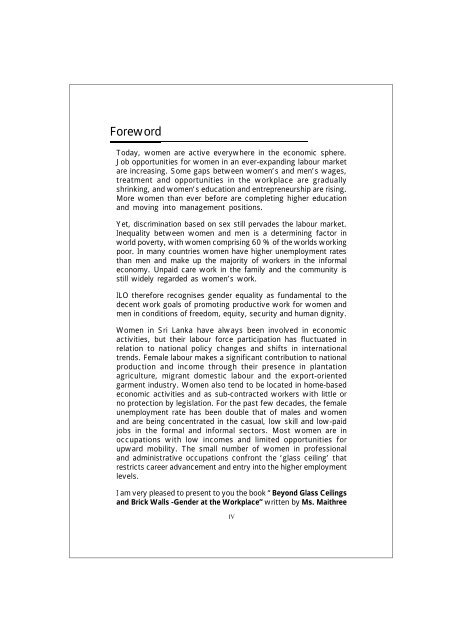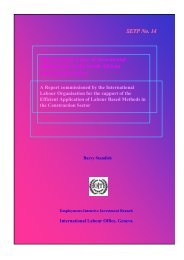Beyond Glass Ceilings and Brick Walls - International Labour ...
Beyond Glass Ceilings and Brick Walls - International Labour ...
Beyond Glass Ceilings and Brick Walls - International Labour ...
Create successful ePaper yourself
Turn your PDF publications into a flip-book with our unique Google optimized e-Paper software.
Foreword<br />
Today, women are active everywhere in the economic sphere.<br />
Job opportunities for women in an ever-exp<strong>and</strong>ing labour market<br />
are increasing. Some gaps between women’s <strong>and</strong> men’s wages,<br />
treatment <strong>and</strong> opportunities in the workplace are gradually<br />
shrinking, <strong>and</strong> women’s education <strong>and</strong> entrepreneurship are rising.<br />
More women than ever before are completing higher education<br />
<strong>and</strong> moving into management positions.<br />
Yet, discrimination based on sex still pervades the labour market.<br />
Inequality between women <strong>and</strong> men is a determining factor in<br />
world poverty, with women comprising 60 % of the worlds working<br />
poor. In many countries women have higher unemployment rates<br />
than men <strong>and</strong> make up the majority of workers in the informal<br />
economy. Unpaid care work in the family <strong>and</strong> the community is<br />
still widely regarded as women’s work.<br />
ILO therefore recognises gender equality as fundamental to the<br />
decent work goals of promoting productive work for women <strong>and</strong><br />
men in conditions of freedom, equity, security <strong>and</strong> human dignity.<br />
Women in Sri Lanka have always been involved in economic<br />
activities, but their labour force participation has fluctuated in<br />
relation to national policy changes <strong>and</strong> shifts in international<br />
trends. Female labour makes a significant contribution to national<br />
production <strong>and</strong> income through their presence in plantation<br />
agriculture, migrant domestic labour <strong>and</strong> the export-oriented<br />
garment industry. Women also tend to be located in home-based<br />
economic activities <strong>and</strong> as sub-contracted workers with little or<br />
no protection by legislation. For the past few decades, the female<br />
unemployment rate has been double that of males <strong>and</strong> women<br />
<strong>and</strong> are being concentrated in the casual, low skill <strong>and</strong> low-paid<br />
jobs in the formal <strong>and</strong> informal sectors. Most women are in<br />
occupations with low incomes <strong>and</strong> limited opportunities for<br />
upward mobility. The small number of women in professional<br />
<strong>and</strong> administrative occupations confront the ‘glass ceiling’ that<br />
restricts career advancement <strong>and</strong> entry into the higher employment<br />
levels.<br />
I am very pleased to present to you the book “<strong>Beyond</strong> <strong>Glass</strong> <strong>Ceilings</strong><br />
<strong>and</strong> <strong>Brick</strong> <strong>Walls</strong> -Gender at the Workplace” written by Ms. Maithree<br />
IV
















